![]() Introduction
Introduction
![]() Sources
Sources
![]() Galileo’s Balance
Galileo’s Balance
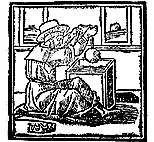
| Back to . . . |
This section . . .
|
|
THE TEN BOOKS
ON ARCHITECTURE
DE ARCHITECTURA LIBRI DECEM
by Marcus Vitruvius Pollio |
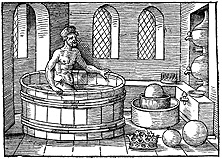
|
|
BOOK IX, INTRODUCTION
9. In the case of Archimedes, although he made many wonderful discoveries of diverse kinds, yet of them all, the following, which I shall relate, seems to have been the result of a boundless ingenuity. Hiero, after gaining the royal power in Syracuse, resolved, as a consequence of his successful exploits, to place in a certain temple a golden crown which he had vowed to the immortal gods. He contracted for its making at a fixed price, and weighed out a precise amount of gold to the contractor. At the appointed time the latter delivered to the king’s satisfaction an exquisitely finished piece of handiwork, and it appeared that in weight the crown corresponded precisely to what the gold had weighed. |
LIBER NONUS, PRAEFATIO
|
| 10. But afterwards a charge was made that gold had been abstracted and an equivalent weight of silver had been added in the manufacture of the crown. Hiero, thinking it an outrage that he had been tricked, and yet not knowing how to detect the theft, requested Archimedes to consider the matter. The latter, while the case was still on his mind, happened to go to the bath, and on getting into a tub observed that the more his body sank into it the more water ran out over the tub. As this pointed out the way to explain the case in question, he jumped out of the tub and rushed home naked, crying with a loud voice that he had found what he was seeking; for he as he ran he shouted repeatedly in Greek, “Εὕρηκα, εὕρηκα” [= “Eureka, eureka” = “I have found (it), I have found (it)”]. | 10. posteaquam inditium est factum, dempto auro tantundem argenti in id coronariú, opus admixtum esse: indignatus Hiero se contemptum, neque inveniens qua ratione id furtum deprehenderet, rogavit Archimedem, uti in se sumeret sibi de eo cogitationem. Tunc is cum haberet eius rei curam, casu venit in balneum, ibiq; cum in solium descenderet, animadvertit quantum corporis sui in eo insideret, tantum aquae extra solium effluere. Itaque cum eius rei rationem explicationis ossendisset, non est moratus, sed exilivit gaudio motus de solio, et nudus vadens domum versus significabat clara voce invenisse quod quaereret. Nam currens identidem graecè clamabat Eurica, Eurica. |
| 11. Taking this as the beginning of his discovery, it is said that he made two masses of the same weight as the crown, one of gold and the other of silver. After making them he filled a large vessel with water to the very brim, and dropped the mass of silver into it. As much water ran out as was equal in bulk to that of the silver sunk in the vessel. Then, taking out the mass, he poured back the lost quantity of water, using a pint measure, until it was level with the brim as it had been before. Thus he found the weight of silver corresponding to a definite quantity of water. | 11. Tum vero ex eo inventionis congressu duas dicitur fecisse massas aequo pondere, quo etiam fuerat corona, unam ex auro, alteram ex argento. Cum ita fecisset, vas amplum ad summa labra implevit aquae, in quo demisit argenteam massam, cuius quanta magnitudo in vase depressa est, tantum aquae effluxit, ita exempta massa, quanto minus factum fuerat refudit, sextario mensus, ut eodem modo quo prius fuerat, ad labra aequaretur. Ita ex eo invenit quantum ad certum pondus argenti certa aquae mensura responderet. |
| 12. After this experiment, he likewise dropped the mass of gold into the full vessel and, on taking it out and measuring as before, found that not so much water was lost, but a smaller quantity: namely, as much less as a mass of gold lacks in bulk compared to a mass of silver of the same weight. Finally, filling the vessel again and dropping the crown itself into the same quantity of water, he found that more water ran over the crown than for the mass of gold of the same weight. Hence, reasoning from the fact that more water was lost in the case of the crown than in that of the mass, he detected the mixing of silver with the gold, and made the theft of the contractor perfectly clear. | 12. cum id expertus esset, tum auream massam similiter pleno vaso demisit, et ea exempta, eadem ratione mensura addita, invenit ex aqua non tantum defluxisse, sed tantum minus, quantum minus magno corpore eodem pondere auri massa esset quàm argenti. Postea vero repleto vase in eadem aqua ipsa corona demissa, invenit plus aquae defluxisse in coronam, quàm in auream eodem pondere massam, et ita ex eo, quod plus defluxerat aquae in corona, quàm in massa, ratiocinatus, deprehendit argenti in auro mixtionem, et manifestum furtum redemptoris. |
Another genius of Archimedes’ rank, Isaac Newton, was 22 and 23 years of age during the two plague years of 1665-1666 when he made his most fundamental discoveries. As Newton later wrote about those years: “I was in the prime age for invention & minded Mathematicks & Philosophy more than at any time since.”
One more genius of Archimedean stature, Galileo, also deserves mention here. Galileo was age 22 when he wrote a little tract in 1586 entitled La Bilancetta, or The Little Balance. In this tract he described an accurate balance for weighing things in air and in water, inspired by Vitruvius’s account of Archimedes’ golden crown problem.
| 600 dpi, | 3550 x 2550 pixels, | black & white gif, | 317 kilobytes | |
| 300 dpi, | 1775 x 1275 pixels, | black & white gif, | 119 kilobytes | |
| 150 dpi, | 888 x 638 pixels, | black & white gif, | 42 kilobytes | |
| 75 dpi, | 444 x 319 pixels, | 256 grayscales gif, | 136 kilobytes | |
![]()
by Plutarch (AD 45-120)
According to the story, Archimedes, as he was washing, thought of a way to compute the proportion of gold in King Hieron’s crown by observing how much water flowed over the bathing-stool. He leapt up as one possessed, crying heureka! ( “I’ve found it”). After repeating this several times, he went his way.
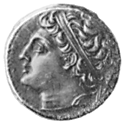 Gelon, son of Hiero |
FIRST BOOK OF EUCLID’S ELEMENTS by Proclus (AD 410-485) BOOK II, CHAPTER III
Tradition has it that Gelon made the same remark when, without destroying the crown that had been made, Archimedes discovered the weight of each of its component materials.
|
(Translation by Glenn R. Morrow (1895-1976) in Proclus: A Commentary on the First Book of Euclid’s Elements, Princeton University Press, Princeton, 1970, Page 51.)
Retold by James Baldwin (1841-1925)
THERE was once a king of Syracuse whose name was Hiero. The country over which he ruled was quite small, but for that very reason he wanted to wear the biggest crown in the world. So he called in a famous goldsmith, who was skillful in all kinds of fine work, and gave him ten pounds of pure gold.“Take this,” he said, “and fashion it into a crown that shall make every other king want it for his own. Be sure that you put into it every grain of the gold I give you, and do not mix any other metal with it.”
“It shall be as you wish,” said the goldsmith. “Here I receive from you ten pounds of pure gold; within ninety days I will return to you the finished crown which shall be of exactly the same weight.”
Ninety days later, true to his word, the goldsmith brought the crown. It was a beautiful piece of work, and all who saw it said that it had not its equal in the world. When King Hiero put it on his head it felt very uncomfortable, but he did not mind that—he was sure that no other king had so fine a headpiece. After he had admired it from this side and from that, he weighed it on his own scales. It was exactly as heavy as he had ordered.
“You deserve great praise,” he said to the goldsmith. “You have wrought very skillfully and you have not lost a grain of my gold.”
There was in the king’s court a very wise man whose name was Archimedes. When he was called in to admire the king’s crown he turned it over many times and examined it very closely.
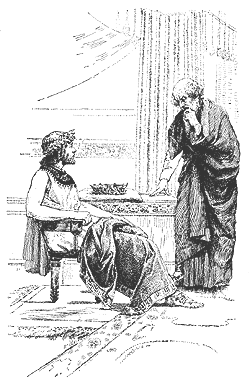
“ ‘Well, what do you think of it?’ asked Hiero. ”
“Well, what do you think of it?” asked Hiero.
“The workmanship is indeed very beautiful,” answered Archimedes, “but—but the gold—”
“The gold is all there,” cried the king. “I weighed it on my own scales.”
“True,” said Archimedes, “but it does not appear to have the same rich red color that it had in the lump. It is not red at all, but a brilliant yellow, as you can plainly see.”
“Most gold is yellow,” said Hiero; “but now that you speak of it I do remember that when this was in the lump it had a much richer color.”
“What if the goldsmith has kept out a pound or two of the gold and made up the weight by adding brass or silver?” asked Archimedes.
“Oh, he could not do that,” said Hiero; “the gold has merely changed its color in the working.” But the more he thought of the matter the less pleased he was with the crown. At last he said to Archimedes, “Is there any way to find out whether that goldsmith really cheated me, or whether he honestly gave me back my gold?”
“I know of no way,” was the answer.
But Archimedes was not the man to say that anything was impossible. He took great delight in working out hard problems, and when any question puzzled him he would keep studying until he found some sort of answer to it. And so, day after day, he thought about the gold and tried to find some way by which it could be tested without doing harm to the crown.
One morning he was thinking of this question while he was getting ready for a bath. The great bowl or tub was full to the very edge, and as he stepped into it a quantity of water flowed out upon the stone floor. A similar thing had happened a hundred times before, but this was the first time that Archimedes had thought about it.
“How much water did I displace by getting into the tub?” he asked himself. “Anybody can see that I displaced a bulk of water equal to the bulk of my body. A man half my size would displace half as much.
“Now suppose, instead of putting myself into the tub, I had put Hiero’s crown into it, it would have displaced a bulk of water equal to its own bulk. All, let me see! Gold is much heavier than silver. Ten pounds of pure gold will not make so great a bulk as say seven pounds of gold mixed with three pounds of silver. If Hiero’s crown is pure gold it will displace the same bulk of water as any other ten pounds of pure gold. But if it is part gold and part silver it will displace a larger bulk. I have it at last! Eureka! Eureka!”
Forgetful of everything else he leaped from the bath. Without stopping to dress himself, he ran through the streets to the king’s palace shouting, “Eureka! Eureka! Eureka!” which in English means, “I have found it! I have found it! I have found it!”
The crown was tested. It was found to displace much more water than ten pounds of pure gold displaced. The guilt of the goldsmith was proved beyond a doubt. But whether he was punished or not, I do not know, neither does it matter.
The simple discovery which Archimedes made in his bath tub was worth far more to the world than Hiero’s crown. Can you tell why?
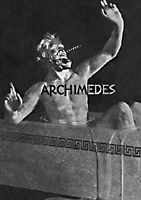
HIS BATH GAVE HIM THE TIP-OFF ARCHIMEDES was asked to check the suspected presence of silver alloy in the king’s gold crown. The solution which occurred when he stepped into his bath and caused it to overflow was to put a weight of gold equal to the crown, and known to be pure, into a bowl which was filled with water to the brim. Then the gold would be removed and the king’s crown put in, in its place. An alloy of lighter silver would increase the bulk of the crown and cause the bowl to overflow. So delighted was Archimedes with his solution that he leaped from his bath and ran through the streets of Syracuse crying “Eureka!” Presumably you won’t be in your bath when you read NBC’s new facts, but we would not be surprised to hear you, too, shout “Eureka!”
(This illustration and text are from a magazine advertisement for NBC, probably dating from the 1940’s. It was found among the files of the Print and Picture Department of the Free Library of Philadelphia. The word “eureka!” is coming out of Archimedes’ mouth.)